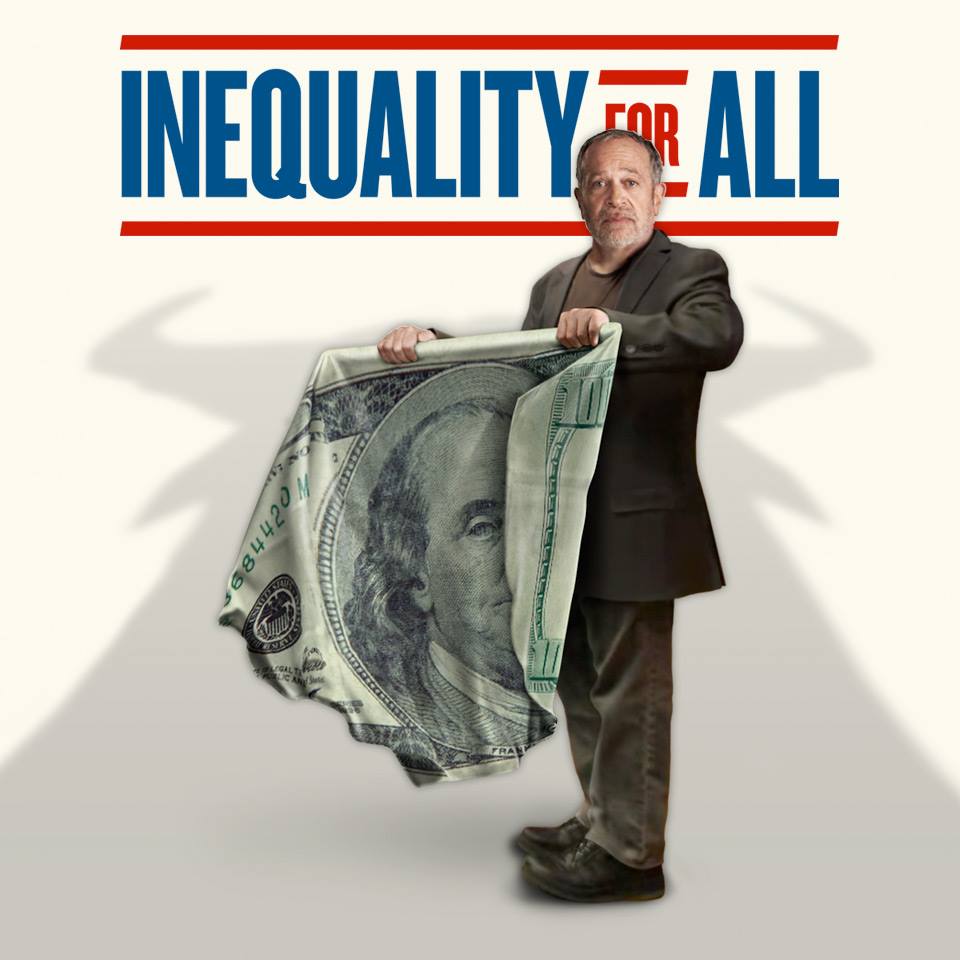
Jacob Kornbluth, the film’s director, states his goal for the film, “…to take a conceptual and abstract topic and find a way to tell an approachable and human story about it. Every choice—from letting Reich’s humor show through to approaching interview subjects as people rather than victims—was designed to help show the argument and the economy in human terms that people could wrap their heads around.”
There are a lot of eye-grabbing statistics, such as, “The 400 richest Americans now own more wealth than the bottom 150 million combined.” Reich sees this disparity as a threat to not only our future economic health, but even more importantly, to our democracy.
Here are a couple of other facts that I scribbled down in the dark of the theater:
The U.S. ranks 64th in the world on income inequality, which means 63 nations are more equal than the U.S. and; In the U.S., 42 percent of children who are born into poverty will not get out.
The poignant personal stories spoke for many throughout out our country:
- Erika and Robert Vaclav: Erika is a Costco employee earning $21.50 per hour and Robert was a manager at Circuit City. The couple purchased a home shortly before the economic crash, but when Robert lost his job, they couldn’t afford to keep it.
- Deborah and Moises Frias: Deborah works at a law firm and Moises is a bus operator. Despite both of them working, they can barely cover basic expenses let alone save for the future.
- Ladd and Nancy Rasmussen: A Republican, middle-class Mormon couple that has managed to make a living despite the recession, they are concerned for the economic well-being of their children, especially because their kids don’t have health insurance.
The documentary also shows an interview with Nick Hanauer, a successful venture capitalist and an early investor in Amazon. To do $70 billion in sales, Hanauer explains, Amazon employs 60,000 workers. If so-called “mom and pop” retail outlets generated that much revenue, he notes, they would employ ten times that many people (600,000 to 800,000 workers).
Hanauer shares that he invests most of his income in hedge funds, which create a return for him (and the hedge fund managers) but do not contribute to expanding wealth for all. To use a question from the film's discussion guide, “What types of investments could wealthy individuals like Hanauer, or people investing in pension plans make that would benefit the entire economy?” Those of us who have dedicated our careers to community development can offer an extensive list.
The film argues that it is the middle class—not the wealthy—who are the true “job creators.” Seventy percent of the U.S. economy is based on consumer spending. The bulk of that spending is done by the middle class. As Hanauer explains, “Even a person like me who earns a thousand times as much as the typical American, doesn’t buy a thousand pillows a year.”
Bottom line: The middle class represents the great stabilizer of the U.S. economy. No increase in spending by the rich can make up for a shrinking or weak middle class.
Two charts at the core of the film should be posted in every office of the members of Congress:
- Virtuous cycle: When we support a strong middle-class, wages increase, workers buy more, companies hire more, tax revenues increase, government invests more (in schools and infrastructure and research), workers are better educated, economy expands, productivity grows, wages increase, etc.
- Vicious cycle: When the middle class doesn’t share in the nation’s economic gains, wages stagnate, workers buy less, companies downsize, tax revenues decrease, government cuts programs, workers are less educated, unemployment rises, deficits grow, wages stagnate, etc.
“Government sets the rules by which the market functions,” Reich says in the film. “All of these rules are necessary to construct a free market. The real question is, who do these rules benefit and who do they hurt?” Yes, that is the question. Who is buying the members of Congress to pursue the vicious cycle?
Reich concludes his lecture stressing that we should be pursuing good jobs, good wages, and good opportunities for our kids. He encourages his students that it is up to them to be the leaders of this mission as they go forward.
At the end of 90 minutes, the screen charges the audience with this message: “The movie is over. Let the work begin.” And now I'm charging the readers: Check out this movie. Tell you kids, families, friends and co-workers to do the same. Consider it an act of patriotism.






I agree – it’s a great documentary. Reich is an engaging, disarming and amusing teacher. He imparts the statistics and tells the stories which help regular people grasp the degree of our fall from economic grace. And the film explains how, if allowed to go unimpeded, this new economic paradigm must finally rot our democracy.
Thank you for raising “Inequality for All” for all our focused attention.
Congratulations Ted this is right on.